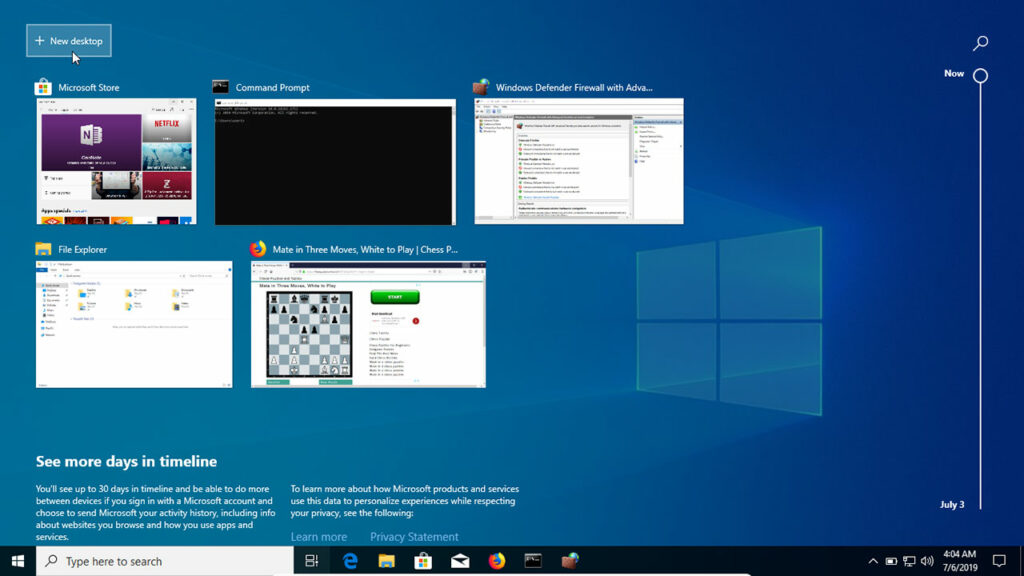Maximizing Productivity: A Comprehensive Guide to Using Multiple Desktops in Windows 10

Introduction
In the quest for enhanced productivity and multitasking efficiency, Windows 10 introduces a powerful feature known as “Multiple Desktops.” This innovative functionality allows users to create and organize virtual desktop spaces, each with its unique set of applications and tasks. Whether you’re a professional managing complex projects or a student juggling various assignments, Multiple Desktops offer a dynamic solution to streamline your digital workspace. In this extensive guide, we will explore the significance of Multiple Desktops, delve into their capabilities, and provide a detailed tutorial on how to leverage this feature to optimize your workflow in Windows 10.
Understanding the Significance of Multiple Desktops
Multiple Desktops in Windows 10 serve as a revolutionary approach to organizing and managing digital workspace. Key aspects that highlight the significance of Multiple Desktops include:
- Enhanced Multitasking: Multiple Desktops provide users with the ability to compartmentalize tasks and applications, reducing clutter on a single desktop and enhancing multitasking capabilities.
- Project Management: Professionals engaged in various projects or tasks can create separate desktops for each project, facilitating a focused and organized approach to project management.
- Optimized Workflow: By segregating different aspects of your work into separate desktops, you can streamline your workflow, ensuring that each desktop serves a specific purpose and contributes to increased efficiency.
- Reduced Distractions: Multiple Desktops enable users to create distraction-free workspaces by isolating specific applications or tasks. This feature proves invaluable for maintaining focus and concentration.
Now, let’s delve into the detailed tutorial on how to set up and use Multiple Desktops in Windows 10.
Step-by-Step Guide: Setting Up and Using Multiple Desktops
Step 1: Access the Task View
- Click on the “Task View” icon located on the taskbar or press
Windows key + Tabto open Task View.
Step 2: Create a New Desktop
- In Task View, locate the “New desktop” option in the lower-right corner and click on it.
- Alternatively, use the keyboard shortcut
Windows key + Ctrl + Dto create a new desktop instantly.
Step 3: Switch Between Desktops
- To switch between desktops, return to Task View and click on the desired desktop. Alternatively, use the keyboard shortcut
Windows key + Ctrl + Left/Right Arrowto navigate between desktops.
Step 4: Move Applications Between Desktops
- Open the application you want to move to another desktop.
- Enter Task View, right-click on the desired application, and select “Move to” to choose the destination desktop.
Step 5: Close Desktops
- To close a desktop, enter Task View, hover over the desktop you want to close, and click on the “X” icon that appears.
- Alternatively, use the keyboard shortcut
Windows key + Ctrl + F4to close the current desktop.
Advanced Features and Tips:
1. Customizing Desktops:
- Rename your desktops to reflect their purpose by right-clicking on the desktop thumbnail in Task View and selecting “Rename.”
2. Keyboard Shortcuts:
- Familiarize yourself with additional keyboard shortcuts, such as
Windows key + Ctrl + F4to close the current desktop orWindows key + Dto minimize or restore all open windows.
3. Taskbar on Multiple Desktops:
- Customize your taskbar settings to display open applications only on the desktop where they are active. Right-click on the taskbar, go to “Taskbar settings,” and toggle on “Show taskbar on all displays.”
4. Pinning Applications:
- Pin frequently used applications to the taskbar on each desktop for quick access.
5. Task View Overview:
- View all open windows across all desktops in Task View to maintain an overview of your active tasks.
6. Keyboard Shortcuts for Desktop Management:
- Use
Windows key + Ctrl + Fto open Task View,Windows key + Ctrl + Left/Right Arrowto navigate between desktops, andWindows key + Ctrl + Dto create a new desktop.
Real-World Applications and Benefits:
- Project-Based Organization:
- Create separate desktops for individual projects, allowing you to maintain a clear focus and keep project-related tasks organized.
- Focused Workspaces:
- Designate specific desktops for different types of tasks, such as one for creative work, one for research, and another for communication, ensuring focused and distraction-free environments.
- Streamlined Task Management:
- Use Multiple Desktops to efficiently manage ongoing tasks, reducing the need to switch between numerous open windows on a single desktop.
- Collaborative Work:
- When collaborating with others, dedicate a desktop to shared applications and communication tools, fostering a collaborative and organized digital workspace.
- Presentations and Meetings:
- Prepare for presentations or online meetings by dedicating a desktop to relevant documents, applications, and communication tools.
Future Developments and Updates:
As Windows 10 continues to evolve, Microsoft may introduce new features, enhancements, and improvements to the Multiple Desktops functionality. Users are encouraged to stay informed about system updates to benefit from the latest developments in desktop management.
Conclusion:
The implementation of Multiple Desktops in Windows 10 signifies a paradigm shift in digital workspace organization and multitasking. By following the comprehensive guide and tips provided in this overview, users can harness the power of Multiple Desktops to create a dynamic, organized, and efficient workspace. As technology progresses, the integration of advanced features exemplifies Microsoft’s commitment to providing users with tools that adapt to the diverse demands of modern computing. Embrace the flexibility offered by Multiple Desktops, and let it become a cornerstone of your digital workflow, allowing you to navigate tasks and projects with unparalleled efficiency and organization.




